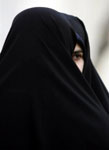 New York Post: In “Reading Lolita in Tehran,” Azar Nafisi captured perfectly the conflicts facing the Iranian woman under the post-revolutionary regime as she wrote of mentoring young women studying English literature, including Nabakov’s notorious “Lolita.” New York Post
New York Post: In “Reading Lolita in Tehran,” Azar Nafisi captured perfectly the conflicts facing the Iranian woman under the post-revolutionary regime as she wrote of mentoring young women studying English literature, including Nabakov’s notorious “Lolita.” New York Post
By QANTA AHMED
 In “Reading Lolita in Tehran,” Azar Nafisi captured perfectly the conflicts facing the Iranian woman under the post-revolutionary regime as she wrote of mentoring young women studying English literature, including Nabakov’s notorious “Lolita.”
In “Reading Lolita in Tehran,” Azar Nafisi captured perfectly the conflicts facing the Iranian woman under the post-revolutionary regime as she wrote of mentoring young women studying English literature, including Nabakov’s notorious “Lolita.”
Problem “solved”: Women will no longer read “Lolita” in Tehran. Last week, 36 Iranian universities announced that 77 undergraduate-degree programs will now exclude Iranian women.
The ban is just another step toward imposing an extreme Islamist ideology central to which is misogyny, anti-Semitism and anti-Zionism. We hear much about the regime’s anti-Semitism, but its misogyny looms as large — indeed, in terms of immediate injustice, larger.
Most discussion of Islamism treats it as a purely Sunni disorder — but the religious ideology of the Iranian Shiite regime shares all the hallmarks of political Islamism enshrined in its “revolutionary” constitution (asRichard Horowitz, a counterterrorism expert and New York attorney who represents Iranian dissidents and former Iranian political prisoners, haspublished at the World Policy Institute).
As a Muslim woman, I’m all too familiar with gender segregation “in the name of Islam” from my time practicing medicine in Saudi Arabia, where Wahabi theocracy legislates and enforces male supremacy.
More than the restrictions on my dress or movement, what jarred me most was the fallacious claim that the exclusion of women from the public space was “founded” in Islam.
This is a heinous distortion of Islam — which enshrines the rights of women, rights particularly likely to be trampled upon by men.
Islam was revealed in pre-Islamic Arabia, a horridly anti-woman culture. Pre-Islamic Arabs often buried female newborns alive, rather than assume the burden of a worthless female.
The Prophet radically broke with such practices — but Islamists seek to roll the calendar back, obscenely citing the Prophet as their authority.
Iran’s elimination of women from certain lines of education — and, soon enough, from other public spaces is nothing more than a modern-day, state-sponsored female “infanticide.”
This is not faith-based — which is why both the extremist Shia administration in Iran and the Sunni Wahhabi theocratic monarchy in Saudi Arabia pursue identical goals.
No, the motivations are purely political: the elimination of women from higher education solidifies increasingly Islamist-centric policies. Iran’s rulers are reacting to the rising power of the female Iranian intellect, which now outcompetes her male counterparts in the nation’s universities — Kryptonite for the Islamist superman.
While not an Arab nation, the Iranian regime is vulnerable to the same turbulence that produced the Arab Spring revolutions. Indeed, Iranian unrest boiled over in the protests over the 2009 election — protests (many led by Iranian women) that were brutally quashed as the West looked on, yet are now considered the vanguard for the wider Arab Spring.
With the nation’s economy in a tailspin thanks to mismanagement and increasing isolation over its nuclear program, Iran grows nervous. It’s plainly attempting to “tie down” the universities — historically the hotbed of political change in Iran.
Nor is it any coincidence that the regime reaches for misogyny as tensions rise with Israel — for misogyny and anti-Semitism are both central to Islamism. Just as the Iranian regime actively seeks the expungement of the Israeli and the Jew, so too it seeks the expungement of the Iranian female intellect.
Take heed: As hardships exacted on Iranian women deepen, so too will the regime’s anti-Semitic and anti-Zionist rhetoric escalate. Extreme speech precipitates extreme action. The time to effect change is rapidly contracting.
Dr. Qanta Ahmed practices medicine in New York. She is the author of “In the Land of Invisible Women.”


